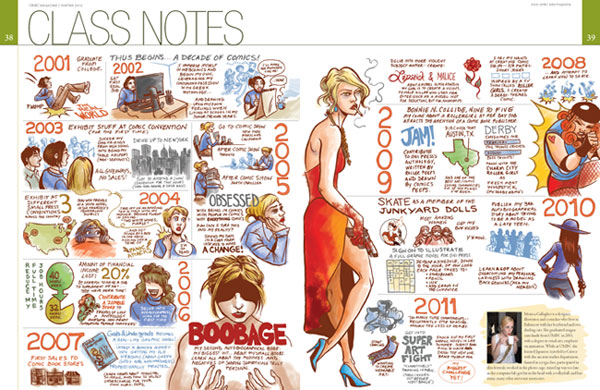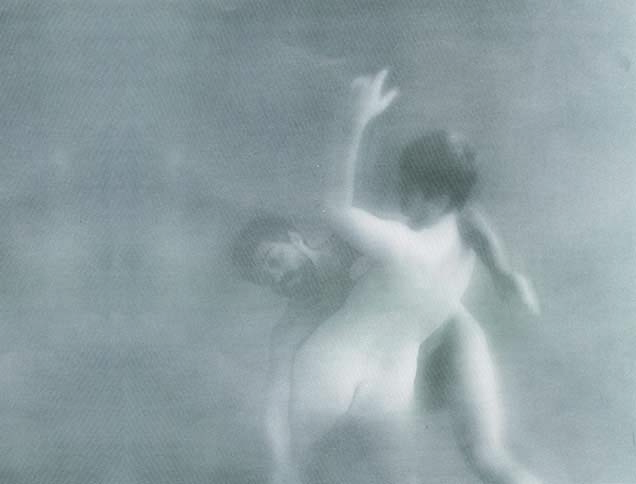It takes a lot of hands to keep UMBC running. Fingers typing in the information to get your transcript in the mail. Gloved hands that keep an experiment in a chemistry or biology lab on course. The fingers of a professor, grasping chalk or a dry-erase pen. Yet there is some work at UMBC that requires a special touch. We’d like you to meet five such employees – members of the university community with jobs that are both surprising and essential to making UMBC a better place.
By Jenny O’Grady
Photos by Chris Hartlove
The Guru of Glass
 Name: Tony Baney
Name: Tony Baney
Occupation: Glass Blower
Time sheet: 13 years at UMBC
 Glass may be fragile. But the process of making it is not for the delicate of hand or heart. Tony Baney, a second-generation glass blower who works in UMBC’s glass shop, manages to keep his cool even while working with his hands ungloved amid Pyrex as hot as 1,500 degrees Celsius. On the floor near his feet, a cardboard box of broken shards bears the sign: “Tony FIX ME please!” A nearby radio blares “Beast of Burden” by the Rolling Stones.
Glass may be fragile. But the process of making it is not for the delicate of hand or heart. Tony Baney, a second-generation glass blower who works in UMBC’s glass shop, manages to keep his cool even while working with his hands ungloved amid Pyrex as hot as 1,500 degrees Celsius. On the floor near his feet, a cardboard box of broken shards bears the sign: “Tony FIX ME please!” A nearby radio blares “Beast of Burden” by the Rolling Stones.
He quickly wipes the sweat away and moves on to his next job, the repair of a piece of glassware used for short path distillation. It first passed through his hands when he made it for the chemistry department. “It’s cheaper to fix it,” he explains, coaxing a seemingly weightless bubble of glass into a U-shape that will allow liquids to flow through like a bendy soda straw. “Hopefully, this doesn’t break, or I have to start all over again.”
Baney learned this dying trade from his father, Narine Baney, who worked in the glass blowing trade at UMBC and elsewhere for 27 years. In addition to fixing dozens of pipettes and other pieces each day, he also works with graduate students to bring to life the complex, Dr. Seuss-esque designs they need for unique experiments.
“I had a design in my head, and I knew I wouldn’t be able to find it anywhere [in catalogs], so I gave it to Tony,” says Margaret Grow, a doctoral candidate in chemistry, who needed a piece of glassware that would allow for dialysis under inert conditions. “It worked perfectly.”
And if it hadn’t? It’d go back to the lathe, to be reshaped, re-curled, and recalibrated under Baney’s watchful eye.
The Caretaker of Creatures
 Name: Rosie Mills
Name: Rosie Mills
Occupation: Lab Animal Technician
Time sheet: 26 years at UMBC
 The rat notices a new person in the room. Rosie Mills notices the rat nervously noticing, and pulls him from his cage, patting him gently on the head. She whispers to him: “I know who is a grump.”
The rat notices a new person in the room. Rosie Mills notices the rat nervously noticing, and pulls him from his cage, patting him gently on the head. She whispers to him: “I know who is a grump.”
Mills has cared for and monitored the rats used in UMBC’s psychology research for more than 25 years, and has never changed her perfume so as not to scare the skittish creatures. “They’re used to their people. Did you know rats scare easier than birds, even?”
A self-professed “animal person,” Mills has filled her cubicle with photos of her personal pets – two doves, a cat (“Nesene,” Cheyenne for “my friend”), “Happy” the hedgehog (a Mother’s Day gift from her children). She would study wolves in the wild if she could, she says, but she feels that time in her life has passed.
The rats in this lab follow a purposely repetitive sort of schedule: feeding, pressing bars for treats, cleaning, weighing, repeat. Mills’ day mirrors theirs, so she moves quickly from task to task according to a communal biological clock she knows by heart. Without her, the lab could not function – the science would literally stop. And the rats? They’d miss a gentle woman who bathes them and slips them the occasional contraband Cheerio.
“I talk to them. I guess people think I’m nuts,” she says. “I stroke them, I scratch them behind the ears. Anything that’s alive needs some love.”
The Queen of Green
 Name: Donna Anderson
Name: Donna Anderson
Occupation: Manager of Landscape and Grounds
Time sheet: 5 years at UMBC
 Nobody sees UMBC’s campus quite like Donna Anderson sees it. To her, every snowflake and drop of water has a destination, every plant a Latin name, and every goose dropping a potential repercussion for the ground underfoot.
Nobody sees UMBC’s campus quite like Donna Anderson sees it. To her, every snowflake and drop of water has a destination, every plant a Latin name, and every goose dropping a potential repercussion for the ground underfoot.
“I look at the university as a small city,” says Anderson, who along with her crew oversees approximately 130 of UMBC’s 500 acres, including 3,500 trees, sidewalks, lawns, animal guests (everything from UMBC’s ubiquitous squirrels to yellow jackets to bagworms) and snow removal.
“To me, it is a place where people come to experience spaces and colors and textures,” she says. “To me, it’s not about the buildings, because I hardly go in the buildings.… It’s what’s outside. It’s what people see from point A to point B.”
A horticulturist by trade, Anderson spent years at public gardens and overseeing the landscape of the city of Frederick, Maryland, before coming to UMBC. Once here, she learned every nook and cranny of the campus – from the curving trails of the Knoll (a section of woods protected from the bulldozers during construction of the Retriever Activities Center) to a treasured beech behind the Math/Psych building.
“There are areas on campus that are such peaceful, comforting spaces,” she says, listing the Joseph Beuys Sculpture Park among her favorites. “I’m lucky to be able to spend so much of my time outside.”
Anderson also serves as the “unofficial head of recycling” on campus, as well as a liaison to UMBC’s landscape and stewardship committee, which last year helped organize the planting of 300 new trees behind Commons garage. She worked with True Grits, the campus dining hall, to institute a composting program, and is a big supporter of the green roof on the new wing of Patapsco Hall that opened last fall.
And then there’s the snow. Anderson is the first in the string of assessments and early morning phone calls that determine how late the campus community gets to sleep in. Much to her chagrin.
“I do dread the winter,” she admits. “Each year I pray for the snow not to start until after the Christmas break.”
The Surveyor of the Stacks
 Name: Lindsey Loeper ’04, American studies
Name: Lindsey Loeper ’04, American studies
Occupation: Archivist, Special Collections
Time sheet: 4 years at UMBC
 Lindsey Loeper ’04 acknowledges the futility of trying to keep pace with the hands of the watch and the rapidly turning pages of the calendar. No matter how quickly she and other members of the Special Collections team archive the stacks of UMBC documents they receive every day, there are always more coming. History never stops happening at a university that’s still building its story.
Lindsey Loeper ’04 acknowledges the futility of trying to keep pace with the hands of the watch and the rapidly turning pages of the calendar. No matter how quickly she and other members of the Special Collections team archive the stacks of UMBC documents they receive every day, there are always more coming. History never stops happening at a university that’s still building its story.
“We’re often asked when we’ll have everything digitized and we never will,” smiles Loeper, who earned her master’s of library sciences at College Park. “Instead, we try to create an online record that can lead you back [to the library], into the stacks.”
Already, the cool, darkened aisles contain 250 shelves stacked with nearly 750 linear feet of physical records, all neatly arranged in gray boxes. Add to that the online digital archives – launched in 2008 to make UMBC’s earliest documents, including many issues of The Retriever Weekly, easily available to the public – and you’re talking years and years of history waiting to be explored.
Just as she was inspired to pursue archive studies by Ed Orser, professor emeritus of American studies, Loeper now enjoys showing current students how to mine the archives, and how to interpret clues within photos, documents and films to make meaningful connections in their own research.
And even though it means perpetually more work down the road, Loeper spends a good deal of time pressing colleagues across campus for copies of magazines, pamphlets – anything that might help researchers of the future better understand the UMBC of today.
“Usually what they say is ‘Do you really want this?’ and I say ‘Yes, yes, yes!’” she says, describing the sometimes incredulous looks she gets when she asks for the contents of faculty and staff closets. “They may not understand why anyone would want to look at this, or why it’s important, but it is. We don’t necessarily think of ourselves as creating history in our everyday work. But it depends on how you look at it.”
The Maker of Music
 Name: Ferdinand Maisel
Name: Ferdinand Maisel
Occupation: Music Coordinator/Dance Accompanist
Time sheet: On, off and around UMBC since 1979
 Before the first note sounds, the dance studio – with its heavy black tape stripes lining the floor – is like an enormous blank page of sheet music. Then, Ferdinand Maisel leans into the keys of the black grand piano in the corner, and suddenly students in sweats and bare feet dot the staff with whole-note pliés and staccato jumps.
Before the first note sounds, the dance studio – with its heavy black tape stripes lining the floor – is like an enormous blank page of sheet music. Then, Ferdinand Maisel leans into the keys of the black grand piano in the corner, and suddenly students in sweats and bare feet dot the staff with whole-note pliés and staccato jumps.
Maisel – one of several accomplished accompanists in the dance program – watches the dancers, not the keys. He follows no score, improvising every phrase, looking to the instructor for signs – a snap, a nod, a clap – that a new beat is needed on the floor.
“Ferd knows more than almost anyone, what dancers need from the music,” says founding dance instructor Liz Walton. “Because he is a composer and not just an accompanist, he can tailor the music to fit what the dancer or instructor needs. Good musicians who simply accompany are not able to do that because they are relying on music they know how to play.”
For the beginner class, Maisel knows to emphasize the beat with a traveling right hand to help keep student leaps in line.
“Ferd is my favorite person in this department,” says senior dance major Ravae Duhaney. “He knows how to work with dancers. He can tell if we are having trouble, and he’ll work to help us. He’s so good at what he does.”
As the mood of movement shifts in class, his internal song shifts: first we had a tango, and now Maisel infuses the room with a Middle Eastern beat found in many of his personal compositions. At times, he switches to a silver QS6.2 electronic keyboard so students can work with other sounds: a violin, or a marimba, an entire orchestra.
“You know, I come to this with gobs of music history,” he says, moving into a new melody. “In a fantasy world, I like to think I’ve helped broaden these students’ perspectives about music.”
Tags: Winter 2012



